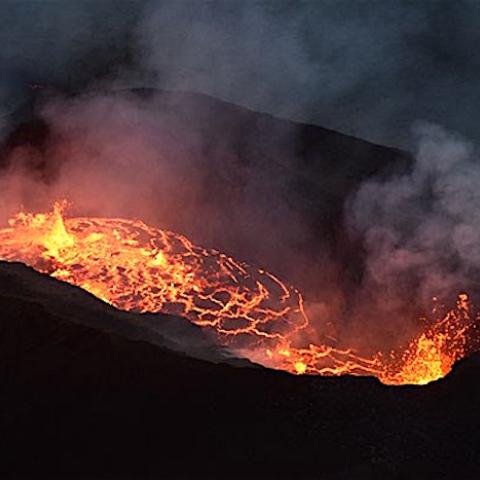It's been five weeks since the most recent eruption of the Kīlauea volcano at Hawai'i Volcanoes National Park ended, but an increase in tremors could produce an eruption at any time, according to the Hawaii Volcano Observatory.
"Elevated unrest to the south-southwest of Kīlauea's summit has continued over the past 24 hours in association with an intrusive event that began in early October. Tremor was observed on seismic stations nearly island-wide today, from approximately 2:20 p.m. to 3:00 p.m., and was strongest at Kīlauea summit," the observatory reported Monday night. "Unrest may continue to wax and wane with changes to the input of magma into the area. The summit of Kīlauea remains at a high level of inflation and eruptive activity at the summit is possible with little or no warning."
The most recent eruption at Kīlauea summit ended on September 16, the observatory noted.
"Following this eruption, seismicity and ground deformation remained at background levels until the first week of October. Rates of ground deformation then began to increase, especially in the region extending from the south caldera to the Koa‘e fault zone," it reported. "A series of seismic swarms began in this region on October 4, 2023, peaking at more than 250 earthquakes on October 5. Magma did not reach the surface, and rates of seismicity and deformation diminished after October 5, suggesting an intrusion. Unrest has continued to wax and wane since then."
When the volcano erupted in September, it awakened after a three-month slumber with lava fountains climbing more than 80 feet into the sky, according to the U.S. Geological Survey.
On Monday the observatory staff reported that "[O]verall inflationary ground deformation has continued intermittently with days-long periods of increased rates alternating with days-long periods of little or no ground deformation. ... Since October 5, intermittent seismic swarms have continued, varying from less than 20 events per day to more than 150 events on October 22."
Most of the quakes have been measured at less than magnitude 2.
"These patterns of ground deformation and earthquakes indicate that a magmatic intrusion is occurring beneath the south-southwest region of Kīlauea’s summit. Numerous intrusions have been recorded here in the past, most recently in 2021 and 2015. In August 2021, an intrusion here occurred over about a week and was followed by an eruption within Halema‘uma‘u about a month later (the eruption that began on September 29, 2021)," the observatory's report pointed out. "In May 2015, an intrusion here lasted less than a week and occurred during ongoing eruptions within Halema‘uma‘u and at Pu‘u‘ō‘ō. Intrusions also occurred here in the 1960s, 1970s, early 1980s, and in 2006, but only one of these events led directly to an eruption in that area."
The disastrous 2018 eruption occurred along the volcano's East Rift Zone, and was called by the U.S. Geological Survey as "the most destructive over the last 200 years in Hawai‘i, with 24 fissures covering an area of over 8,700 acres (35.5 square km) including the addition of 875 acres of new land beyond the old coastline. Over 700 structures and 30 miles (48 km) of roads were covered, displacing many residents. Gas emissions were at the highest levels ever recorded at Kīlauea and impacted much of the State of Hawaii and areas as far away as Guam."




 Support Essential Coverage of Essential Places
Support Essential Coverage of Essential Places







Add comment